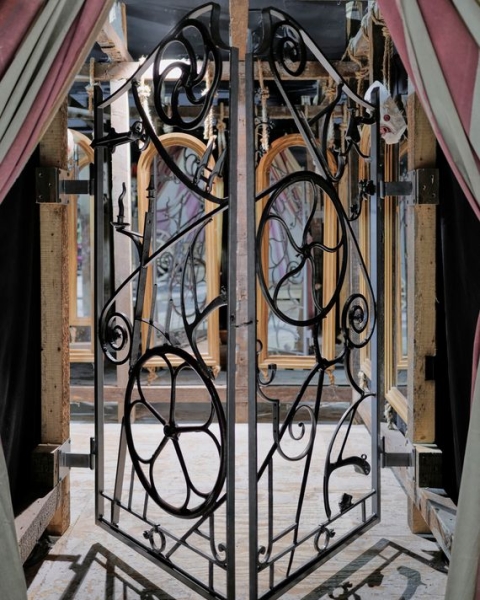Masquerade is one of the most coveted and expensive tickets in New York theater right now. It re-envisions The Phantom of the Opera as an immersive, romantic experience in a random building in midtown — with a secret password required to enter the venue to thwart interlopers. You’re ushered from room to room as the performance unfolds, and, if you’re lucky enough to avoid a rainy day, you also get a showstopper of a number on the roof. Multiple artists, including Marina Abramović, are credited as fine-arts collaborators for Masquerade, all of whom allowed the production to feature their thematically appropriate work. That list also includes a new piece from Bob Dylan, who was commissioned to weld ironwork gates specifically for the show. We’re surprised that Dylan didn’t tweet the news out himself but rather relied on a small note in the playbill to confirm his involvement. But hey, he’s busy hiding himself in a hoodie behind his piano on the Never Ending Tour.
Masquerade’s creative director, Shai Baitel, who has been working with Dylan as a curator for about eight years, thought of his acquaintance even before the space was finalized. The famed musical and Dylan’s body of work, Baitel argues, share several similarities. “Bob is very connected to Paris. This is something that has influenced his entire career,” he explains. “The Paris of the late 1800s, when the Phantom story was conceived, made me suggest including him. There was a wealth of his artwork that I could look into and review.” (And don’t even get fans started about his Phantom-referencing “Desolation Row” lyrics.) Baitel pitched Masquerade’s conceit to Dylan and his team, stressing that it wasn’t a conventional musical — it was instead an intimate and audience-oriented experience infused with a bit of Sleep No More spirit. Masks would be required for every guest, and Champagne was served as you entered. “I showed them the set and explained how exactly I’m planning to include it,” he said. “Because Bob is very specific. He isn’t easy to convince.”
Dylan’s intricate gate work, some of which have been displayed in galleries before, was the first thing Baitel thought of for a commission. All of Dylan’s gates are made of found objects from Minnesota, mostly metallic shrapnel from bridges and railroads. “It’s a repetitive motif for him,” Baitel says. “I think much of the reason is because he traveled so much throughout the country and he used to go by car and train. He would draw his own memories from landmarks. His approach of visiting, looking, and observing was in the back of my mind and had a lot to do with the Phantom’s psychology.” When Dylan was eventually convinced to take the commission, which was worked on between 2024 and 2025, it became the first time he created a piece just for the theater. While a nondisclosure agreement prevents Baitel from sharing the price of Dylan’s work, he confirms “a lot was invested in it.”
Click here to preview your posts with PRO themes ››

Bob Dylan, “Phantom Gates,” (2024-2025) Photo: Clara Melchiorre
It was initially believed that Dylan’s gates would work best for an outdoor graveyard scene involving the protagonist Christine Daaé. Baitel, however, changed his idea and installed them in Masquerade’s indoor carnival room, given that all outdoor scenes are dependent on weather conditions. Occurring more than halfway through the performance, the scene is used to introduce the tragic backstory of the Phantom character at a freak show — a new narrative deviating from the original source material. “When you enter the mirror maze, there’s Dylan’s gates that are welcoming you, and when you exit it’s a farewell,” Baitel says. “If you look carefully, you can see there’s some elements from Phantom, like roses, incorporated into his art. There’s so much in Dylan’s approach to the way he sees the world and society. The Phantom had a chance to see society, but it was very cruel for him. And he evolved into the genius creature when he was isolated, whereas Dylan was very connected to society. I was very intrigued by this dichotomy. The Phantom is the genius of music and Bob is the genius of everything.” Dylan’s final product, which he named simply Phantom Gates, then had to be transported to Manhattan from his studio in Los Angeles.
Dylan, ever the elusive boxer, has yet to experience Masquerade and marvel at his handiwork in person. “We never know if he’ll show up, even if it’s an exhibition that we’re opening with his art,” Baitel admits. “We don’t know until the very last minute. He doesn’t tell us.” Should he choose to come in the future, though, the conditions of anonymity are pretty ideal. “It’s a comfortable fit for him because with a mask and hat, nobody would know,” he says. “He can just put on his hoodie and go.”


